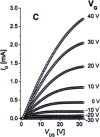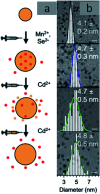Frontier challenges in doping quantum dots: synthesis and characterization
- PMID: 35541736
- PMCID: PMC9081084
- DOI: 10.1039/c8ra03530j
Frontier challenges in doping quantum dots: synthesis and characterization
Abstract
Impurity doping in semiconductor quantum dots (QDs) has numerous prospects in implementing and altering their properties and technologies. Herein, we review the state-of-the-art doping techniques arising from colloidal synthesis methods. We first discuss the advantages and challenges involved in doping; we then discuss various doping techniques, including clustering of dopants as well as expulsion out of the lattice due to self-purification. Some of these techniques have been shown to open up a new generation of robust doped semiconductor quantum dots with cluster-free doping which will be suitable for various spin-based solid-state device technologies and overcome the longstanding challenges of controlled impurity doping. Further, we discuss inhibitors such as defects, clustering and interfaces, followed by current open questions. These include pathways to obtain uniform doping in the required radial position with unprecedented control over the dopant concentration and the size of the QDs.
This journal is © The Royal Society of Chemistry.
Conflict of interest statement
There are no conflicts to declare.
Figures
















Similar articles
-
Doping silicon nanocrystals and quantum dots.Nanoscale. 2016 Jan 28;8(4):1733-45. doi: 10.1039/c5nr04978d. Nanoscale. 2016. PMID: 26727507 Review.
-
"Quantized" Doping of Individual Colloidal Nanocrystals Using Size-Focused Metal Quantum Clusters.ACS Nano. 2017 Jun 27;11(6):6233-6242. doi: 10.1021/acsnano.7b02369. Epub 2017 May 16. ACS Nano. 2017. PMID: 28485979
-
An Aqueous Route Synthesis of Transition-Metal-Ions-Doped Quantum Dots by Bimetallic Cluster Building Blocks.J Am Chem Soc. 2020 Sep 23;142(38):16177-16181. doi: 10.1021/jacs.0c07274. Epub 2020 Sep 14. J Am Chem Soc. 2020. PMID: 32914627
-
Diffusion doping in quantum dots: bond strength and diffusivity.Nanoscale. 2017 Feb 23;9(8):2806-2813. doi: 10.1039/c6nr09839h. Nanoscale. 2017. PMID: 28155949
-
Cu-doped quantum dots: a new class of near-infrared emitting fluorophores for bioanalysis and bioimaging.Luminescence. 2019 Dec;34(8):782-789. doi: 10.1002/bio.3679. Epub 2019 Jul 11. Luminescence. 2019. PMID: 31297953 Review.
Cited by
-
Recent Advances in HPV Detection: From Traditional Methods to Nanotechnology and the Application of Quantum Dots.Int J Nanomedicine. 2025 May 21;20:6333-6356. doi: 10.2147/IJN.S524518. eCollection 2025. Int J Nanomedicine. 2025. PMID: 40420910 Free PMC article. Review.
-
Red emitting carbon dots: surface modifications and bioapplications.Nanoscale Adv. 2023 Aug 3;5(17):4337-4353. doi: 10.1039/d3na00469d. eCollection 2023 Aug 24. Nanoscale Adv. 2023. PMID: 37638168 Free PMC article. Review.
-
Numerical Model to Simulate Electrochemical Charging of Nanocrystal Films.J Phys Chem C Nanomater Interfaces. 2023 May 15;127(20):9896-9902. doi: 10.1021/acs.jpcc.3c01562. eCollection 2023 May 25. J Phys Chem C Nanomater Interfaces. 2023. PMID: 37255927 Free PMC article.
-
Composite formation in CdSe:Cu2Se nanocrystal films, charge transport characteristics and heterojunction performance.RSC Adv. 2020 Mar 2;10(15):8842-8852. doi: 10.1039/c9ra10251e. eCollection 2020 Feb 27. RSC Adv. 2020. PMID: 35496572 Free PMC article.
-
Deterministic Structural Distortion in Mn2+-Doped Layered Hybrid Lead Bromide Perovskite Single Crystals.ACS Nano. 2025 Jul 29;19(29):26920-26931. doi: 10.1021/acsnano.5c08324. Epub 2025 Jul 17. ACS Nano. 2025. PMID: 40674607 Free PMC article.
References
-
- Norris D. J. Yao N. Charnock F. T. Kennedy T. A. Nano Lett. 2001;1:3–7. doi: 10.1021/nl005503h. - DOI
Publication types
LinkOut - more resources
Full Text Sources

